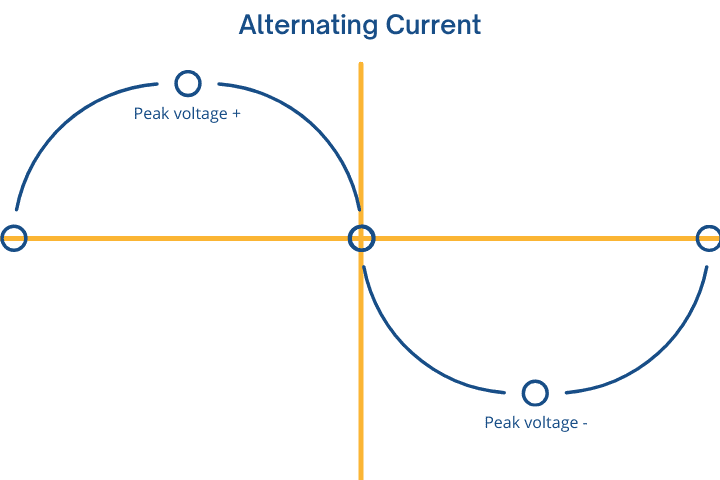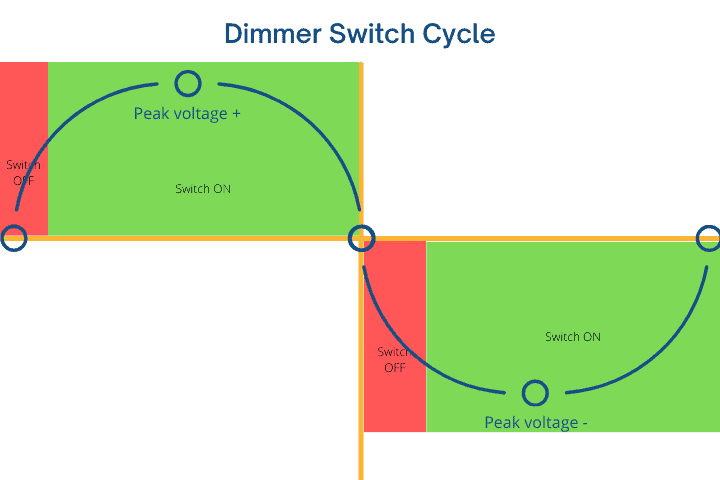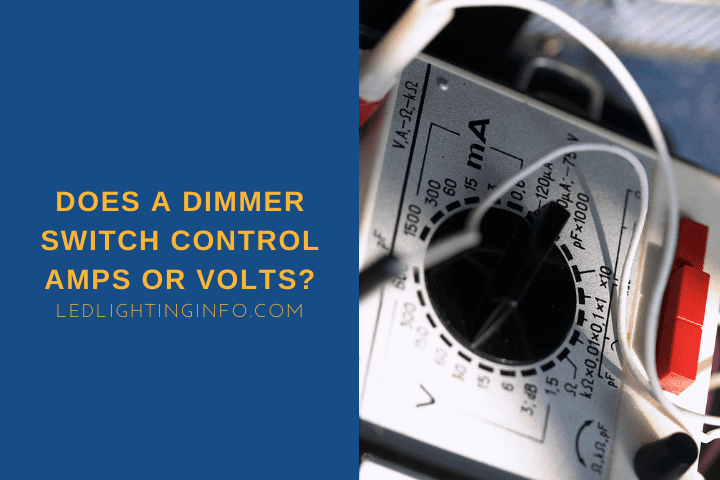While you could have a dimmer switch installed for you and just be happy that it does what it’s supposed to, it’s always better to understand how the electrical components in your home actually work.
Lighting systems and anything to do with circuitry can seem really complicated, and dimmer switches are no different.
How does this little dial or slider switch make it so that your lights get brighter or dimmer? Is it more amps?
More volts? Something else?
A dimmer switch doesn’t control amps, and it doesn’t directly control volts. Instead, it interrupts the alternating current (AC) voltage. It’s not reducing the voltage but limiting the flow by switching the current on and off, which provides the dimmed effect.
Like I said – quite complicated, especially if you’re not particularly savvy with electrical circuits. Don’t worry though – by the end of this guide you’re going to understand:
- The difference between amperage and voltage
- How a dimmer switch works on a circuit
- What that means the dimmer switch is adjusting
What is the Difference Between Amperage and Voltage?

Before we get into whether a dimmer switch controls amps or volts, it’s good to start by explaining the differences between them.
Amperage and voltage are both measurements of electrical current.
Amperage is a measurement of the volume of electrons moving through a circuit. At the same time, voltage is a measurement of the pressure that permits the electrons to flow.
There’s a perfect analogy that some experts use here, comparing electrical current to a river.
Amperage is the volume of water, and voltage is the angle at which the river is flowing.
A river with low amperage and high voltage would have a low amount of water on an extremely high angle – like a gently trickly waterfall.
While a high amperage and low voltage would be a massive deep river flowing slower due to the low angle.
The analogy works well because it’s also reflective of the danger.
A circuit with low amperage and high voltage isn’t going to be as dangerous as one with high amperage and low voltage.
Just like a tiny trickling waterfall isn’t as risky as a massive deep river, no matter how slow it’s moving.
Most lighting circuits in the US are 120 volts with a flow of 15 amps, although you may have other circuits that are 20 amps.
How Does a Dimmer Switch Work on a Circuit?

So now that we understand the voltage and amperage of a home lighting circuit do we know enough to understand how a dimmer switch works?
Not quite. Because we also need to explain alternating current first.
Alternating current (AC) concerns the direction of the flow of electrons.
As the name suggests, it alternates – it travels in one direction (positive) and then reverses (negative). It does a complete cycle (positive and negative) 60 times a second for a current of 60 hertz.
It’s an undulating sine wave, which starts from zero voltage, rises to the peak voltage of 120 volts positive, returns to zero voltage, then drops to 120 volts negative before returning to zero.

A dimmer switch interrupts that curve whenever it’s at the zero voltage mark, pausing before resuming it.
It’s essentially switching the current on and off. So the voltage doesn’t change – it still reaches its peak, but it doesn’t have that gentle curve to get to it.
The longer the pause before switching the current back on, the less current constantly flows through the light, so the dimmer the bulb.
If you set the dimmer to maximum, there won’t be a pause, as it just won’t switch the current off, but set it to the lowest setting, and it’ll pause for a longer time.

Remember that the cycle happens 60 times a second, meaning the curve passes through zero voltage 120 times a second.
So there are 120 mini off/on cycles every second.
But because it’s happening when the voltage is at zero, it doesn’t make the light flicker at all.
What Does the Dimmer Switch Adjust?

With alternating current now clear, and a clearer picture of what voltage and amperage are, we can now understand what a dimmer switch is actually changing.
To do this, I’m going to go back to the water analogy from earlier, but in a slightly different way.
Imagine you have a sealed pipe that is elevated and fixed to a hinge in the center, containing a gallon of water.
You can tip this pipe from both ends, which obviously tips that gallon of water down to the other side of the pipe.
On an average AC current, you would gently move the pipe to its maximum height on one side and immediately return it to the full height on the other side.
The water would constantly be flowing back and forth.
With a dimmer active, every time the pipe is perfectly level, you briefly hold it still before quickly tilting it to the position it would’ve been in had you not paused.
The volume of water represents the amperage – the total number of electrons flowing in the circuit.
That hasn’t changed.
The voltage represents the maximum height you can tip the pipe too, which hasn’t changed.
You are still tipping that pipe to its maximum height only after a brief pause.
What you’re doing instead is interrupting the smooth motion of tipping it back and forth without stopping.
After you’ve stopped, you’re not going back to a gentle motion.
You’re quickly making up for the lost time by tilting it quickly to put it into the position it would be in if it hadn’t paused.
And that’s what a dimmer switch is doing. It doesn’t control amps, and it doesn’t control the maximum voltage.
But it does control the alternating current and how that relates to the voltage, the angle of the pipe, and how it fluctuates.
Also read: Can LED Bulbs Be Used On A Dimmer?
Final Words
Despite the two being a dangerous combination, the water’s a good metaphor for electricity in general.
Hopefully, now it’s clear how a dimmer switch does its job.
It’s a disruptor, constantly switching the current on and off at speed so fast that it doesn’t stop the lights from working. Instead, it just lowers their overall current to dim them.
Pretty clever, right?

